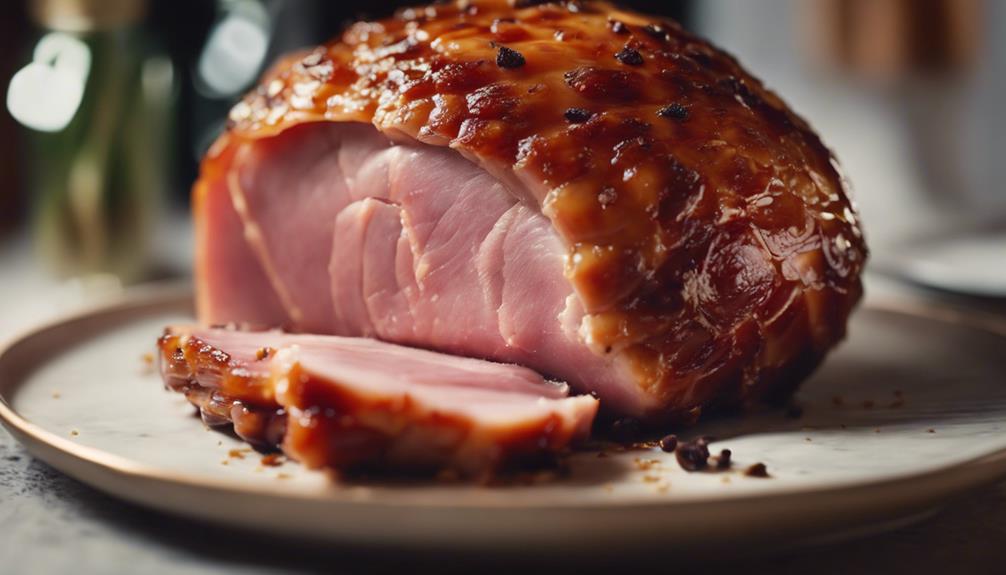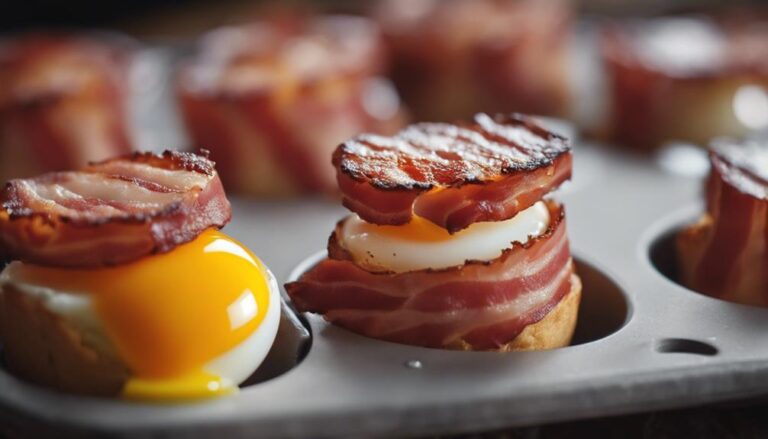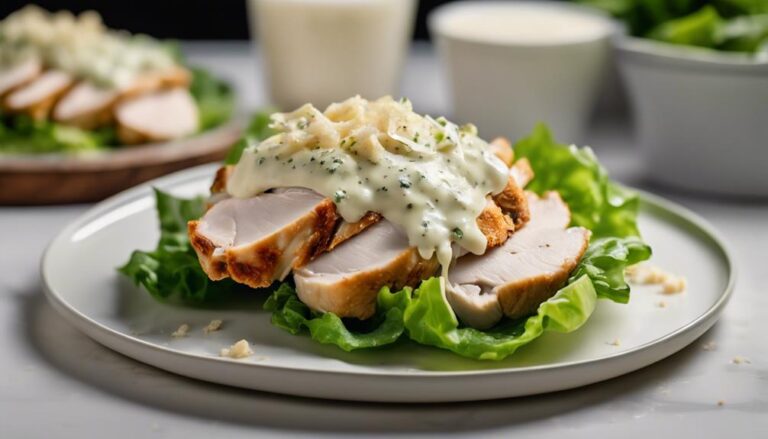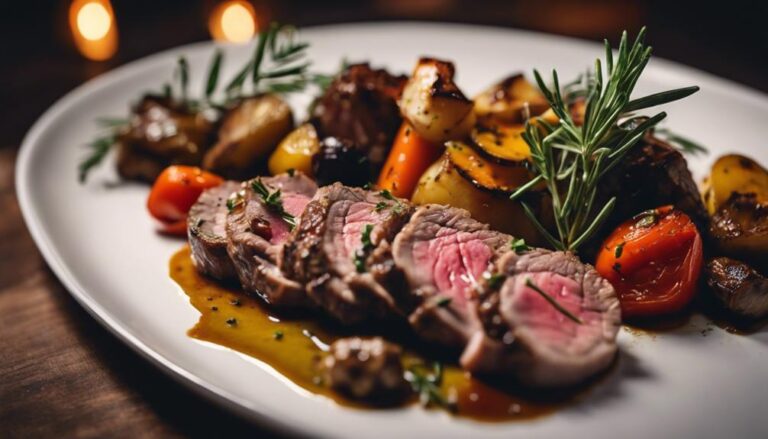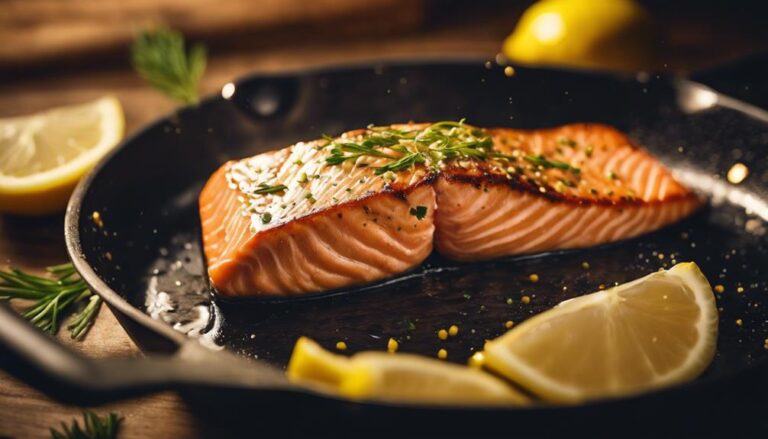Sous Vide Glazed Ham With Clove and Mustard
Step into a world of flavor with sous vide glazed ham, where the marriage of cloves and mustard creates an enticing taste sensation. Experience the perfect balance of sweet and tangy notes that elevate this traditional dish to new heights. Every bite offers a symphony of flavors that will leave your taste buds craving more. Explore the art of infusing ingredients and techniques to create a culinary masterpiece that will impress any palate. Uncover the secrets to achieving a caramelized, shiny exterior that will have your guests asking for seconds. Discover the magic of sous vide cooking with this delightful glazed ham.
What You Will Learn Here
- Sous vide cooking retains ham's moisture and tenderness.
- Use cloves and mustard for a classic and tangy flavor profile.
- Enhance glaze absorption by scoring the ham before cooking.
- Experiment with different glazes for unique taste experiences.
- Elevate visual presentation for an unforgettable dining experience.
Ham's Evolutionary Timeline
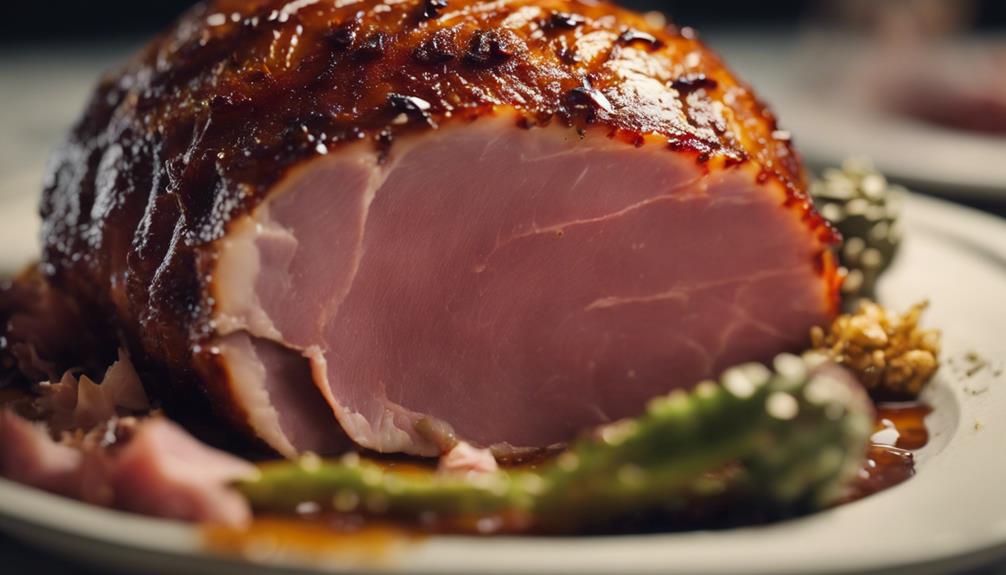
Explore the rich tapestry of ham's journey through history, from its humble beginnings of salted and smoked preservation to the elaborate glazed creations of today.
Witness the evolution of ham preparation techniques that have been refined over centuries, each step adding layers of flavor and cultural significance to this beloved dish.
Investigate the global impact of ham, where different regions and traditions have woven their unique culinary identities into the art of glazing ham.
Ham's Historical Origins
Through the annals of time, ham has stood as a cornerstone to the art of meat preservation and culinary evolution, tracing back to ancient civilizations. Dating back to ancient times, ham was a vital method for preserving meat, allowing civilizations to store and consume meat over extended periods.
The historical origins of ham reveal a rich tapestry of techniques and traditions that have shaped its evolution into the varieties we enjoy today, such as city ham, country ham, and spiral-sliced ham. Different cultures have added their unique flavors and methods to preparing ham, contributing to the diverse culinary landscape surrounding this beloved dish.
Understanding the historical roots of ham provides valuable insights into its transformation over the ages, making it a staple for celebratory feasts and gatherings.
Evolution of Ham Preparation
Ham's journey from a preservation method to a culinary delicacy has seen a remarkable evolution in preparation techniques over the centuries, reflecting a tapestry of traditions and flavors from diverse cultures.
Traditional methods of preparing ham have undergone a modern twist with the introduction of sous vide cooking. This innovative technique involves vacuum-sealing the ham and cooking it in a precisely controlled water bath for an extended period, resulting in consistently tender and flavorful meat. Sous vide allows for the infusion of ingredients like cloves and mustard, enhancing the depth and complexity of glazed ham.
The evolution of ham preparation showcases how culinary traditions adapt and thrive, incorporating new technologies to elevate classic dishes to new heights of taste and texture.
Cultural Significance of Ham
In the intricate tapestry of culinary history, ham emerges as a symbol of tradition and cultural significance. It traces its origins back to ancient civilizations and has evolved over time into a revered dish enjoyed in various cultural celebrations.
From ancient Rome to Chinese and Germanic cultures, ham has been a part of traditional feasts and rituals. It symbolizes wealth and prosperity due to its labor-intensive curing and smoking process. As the technique of curing and smoking ham spread throughout Europe during the Middle Ages, it became a staple food in many regions. Each area developed unique recipes and flavor profiles.
The cultural significance of ham is evident in the central role it plays in holidays like Christmas, Easter, and Thanksgiving. Its presence signifies festivity and abundance.
Honey and Clove Glaze
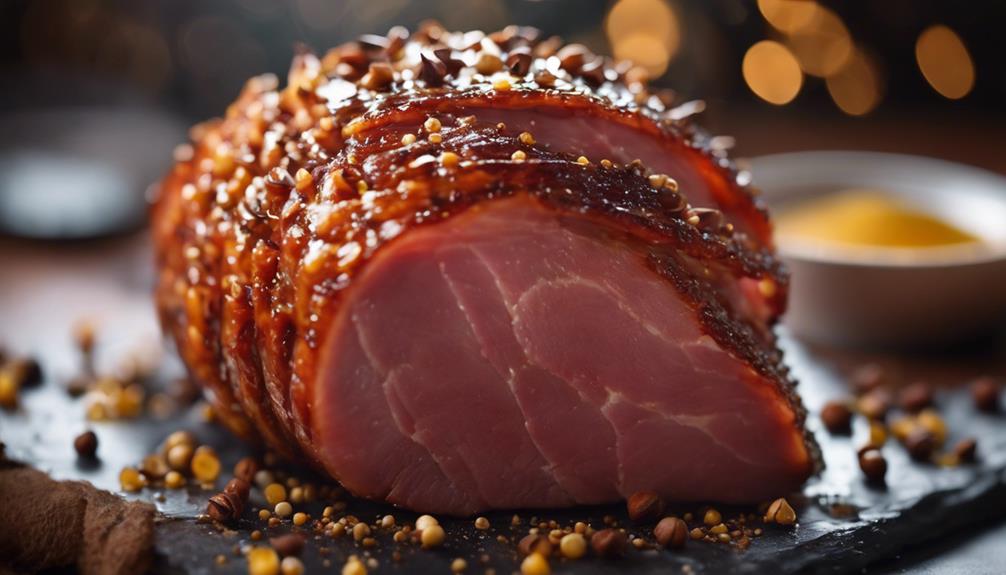
Enhance the sous vide glazed ham with a tantalizing blend of honey and cloves in a rich and aromatic glaze. The honey and clove glaze adds a sweet and aromatic flavor profile, elevating the ham to a new level of deliciousness. Here's why this glaze is a must-try:
- Warm and Spicy Undertone: Cloves, along with the sweetness of honey, infuse the glaze with a warm and spicy undertone that perfectly complements the savory ham.
- Richness and Balance: The combination of honey and cloves creates a well-balanced taste, enhancing the overall richness of the glaze and adding depth to each bite.
- Beautiful Caramelization: During the final browning process, the glaze caramelizes beautifully on the ham, forming a glossy and flavorful finish that will delight your taste buds.
Tasty Ham Creations
Explore the diverse world of tasty ham creations with sous vide techniques like the savory Clove Ham, the rich Balsamic-Roasted Onions Ham, and the sweet Pineapple-Glazed Ham Variation.
These mouthwatering variations offer a range of flavors and textures, showcasing the versatility of ham dishes.
Elevate your culinary skills by experimenting with different glazes and cooking methods to create unforgettable ham dishes for your next gathering.
Sous Vide Ham With Clove
For an exquisite culinary experience, infuse your ham with the warm and aromatic essence of clove in this sous vide cooking adventure.
Here's why this method creates a delectable dish:
- Consistent Texture: Sous vide cooking involves submerging the ham in a water bath at a precise temperature, ensuring an even and tender result.
- Aromatic Flavor: Cloves bring a warm and fragrant taste to the ham, enhancing its overall richness.
- Juicy Outcome: By cooking the ham sous vide, it retains its moisture, resulting in a succulent and flavorful dish.
Sous vide ham with clove not only offers a delightful sensory experience but also guarantees a perfectly cooked ham that will impress your guests at any gathering.
Balsamic-Roasted Onions Ham
Infuse your culinary repertoire with a tantalizing twist by savoring the succulent flavors of Balsamic-Roasted Onions Ham, a delectable creation that elevates the traditional ham experience. When preparing this dish, you can expect:
- Balanced Flavors: The ham, glazed with brown sugar and Dijon mustard, offers a harmonious blend of sweet and tangy notes.
- Rich Infusion: Slow cooking allows the ham to absorb the rich flavors, enhancing its taste profile.
- Caramelized Onions: Paired with caramelized cipollini onions, this dish delivers a depth of flavor that goes beyond the ordinary ham experience.
Roasting the ham with balsamic-roasted onions intensifies the savory and sweet elements, making Balsamic-Roasted Onions Ham a delightful choice for those seeking a unique and delicious ham recipe.
Pineapple-Glazed Ham Variation
Pineapple-Glazed Ham Variation
Enhance your culinary repertoire with a tantalizing twist by indulging in the tropical flavors of Pineapple-Glazed Ham Variation, a delightful departure from traditional ham recipes. The combination of pineapple and ham creates a sweet and tangy flavor profile, perfect for a unique dining experience.
Here's why this variation stands out:
- Sweet and Tangy: The pineapple juice in the glaze adds a perfect balance of sweetness and tanginess to the ham.
- Acidity and Caramelization: The acidity from the pineapple juice helps in caramelizing the ham, enhancing its overall flavor and texture.
- Popular Choice: This variation is a popular choice for those seeking a flavorful and distinctive ham preparation.
Ham Glazing Techniques
When glazing your ham, the selection of glaze ingredients plays a pivotal role in determining the final flavor profile. The glazing process involves a meticulous overview of scoring, drying, and even application to guarantee an even distribution of flavors.
To enhance the taste of your ham, consider incorporating tips for infusing flavors effectively throughout the glazing process.
Glaze Ingredients Selection
For ham glazing techniques, the selection of glaze ingredients plays an essential role in achieving a perfect balance of flavors. When considering maple syrup as a key component, its rich sweetness can complement the saltiness of the ham, creating a harmonious blend of tastes.
Combining maple syrup with brown sugar adds depth to the glaze, while Dijon mustard brings a hint of sharpness and complexity. Additionally, incorporating apricot jam can introduce a fruity note that contrasts beautifully with the savory elements.
The interplay of these ingredients showcases the importance of thoughtful selection in creating a glaze that enhances the overall appeal of the ham, making it a delightful centerpiece for any gathering.
Glazing Process Overview
The glazing process for ham involves meticulously applying a flavorful mixture to the ham's surface to enhance its taste and appearance. When glazing a ham, you're aiming to create a beautiful caramelized and shiny exterior that not only looks appealing but also adds a depth of flavor to each bite. Common ingredients like cloves and mustard are often used in glazes to provide a perfect balance of sweet and savory notes.
Techniques such as basting the ham with the glaze while cooking or scoring the surface to allow the flavors to penetrate deeper can elevate the final presentation. Remember, the glazing process can be tailored to suit your preferences and desired flavor profiles, making each glazed ham unique and delightful.
Flavor Infusion Tips
Enhancing the ham's flavor profile through strategic infusion techniques elevates its taste to a new level of culinary excellence. When working with a bone-in ham, consider injecting a brine solution directly into the meat for deep flavor penetration. Slow simmering the ham with cloves, onions, and other aromatics further enriches its taste profile. For a tangy and savory finish, use a mustard-based glaze that complements the ham's natural flavors. Score the ham before applying the glaze to allow the flavors to seep into the meat effectively. The combination of cloves and mustard in the glaze creates a classic and aromatic taste that will impress your guests.
| Flavor Infusion Techniques | Benefits | Tips |
|---|---|---|
| Injecting brine | Deep flavor infusion | Use a syringe for precise distribution |
| Simmering with aromatics | Enhances taste | Include a variety of spices for complexity |
| Mustard-based glaze | Adds tangy and savory layer of flavor | Adjust mustard quantity to personal taste |
Final Thoughts
Considering the intricate preparation and unique flavors in this Sous Vide Glazed Ham recipe, final thoughts on its execution and presentation are crucial for a memorable dining experience.
The process of cooking the ham in a water bath guarantees that it retains its moisture and tenderness, setting the stage for a succulent dish that will delight your guests. As you carefully score the ham skin post sous vide cooking, you create the perfect canvas for the flavorful clove and mustard glaze to shine. This attention to detail not only enhances the visual appeal of the dish but also allows the flavors to penetrate the meat, offering a harmonious blend of sweet and savory notes in every bite.
When serving this Sous Vide Glazed Ham, take a moment to appreciate the effort that went into its creation. The multi-day brining process and precise cooking technique culminate in a dish that isn't just food but a work of culinary art. By presenting this ham with elegance and flair, you elevate the dining experience, making it a feast for both the eyes and the taste buds. Embrace the opportunity to share this unique twist on a classic dish with your loved ones, creating lasting memories around the table.
Frequently Asked Questions
How Do You Glaze a Sous Vide Ham?
To glaze a sous vide ham, score it for better flavor absorption. Apply a thick glaze mixture before browning in the oven for a glossy finish. Use high heat to caramelize and achieve a golden-brown exterior.
Should I Put Cloves in My Ham?
You should consider putting cloves in your ham. The Cloves Debate centers around enhancing flavor. They bring warmth and depth, adding a festive aroma. Combined with mustard, they create a well-balanced glaze that elevates the overall taste profile of your ham.
Why Do People Put Mustard on Ham?
People put mustard on ham for its tangy flavor that complements the meat's savory profile. Mustard's acidity balances the richness of ham, acting as a binding agent for glazes with brown sugar and spices, creating a delicious coating.
How Long Before a Ham Is Done Should You Glaze It?
When glazing a ham, time it right for a perfect finish. Apply the glaze around 30 minutes before the ham is done. This guarantees the sugars caramelize without burning, infusing the flavors throughout the meat for a harmonious taste.
Conclusion
Indulge in the succulent flavors of sous vide glazed ham with clove and mustard. The honey and clove glaze adds a perfect balance of sweetness and spice, creating a truly unforgettable dish.
Experiment with different glazing techniques to elevate your ham to new levels of deliciousness. Whether you're a ham connoisseur or just looking to try something new, this recipe is sure to impress your taste buds.
Happy cooking and enjoy every bite of this delectable ham creation!
